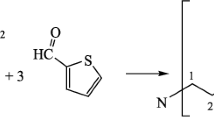Abstract
Complexation of 99, 99mTc(CO) +3 organometallic fragment with 2 + 1 chelating systems was studied. HPLC analysis showed that the dithiocarbamate complexes of 99mTc are stronger than their xanthate, acetylacetonate, and γ-methoxycarbonylmethylacetylacetonate analogs. To block the third vacancy in the technetium coordination sphere, we studied thiols, thioethers, primary and secondary amines, hydroxyl ion, imidazole, phosphines, and isocyanides. As determined by 99mTc NMR spectroscopy, the mixed-ligand complexes Tc(CO)3(DTC)L (DTC is dithiocarbamate and L is isocyanide, imidazole, and phosphine) are the most stable to the histidine challenge reaction. HPLC analysis showed that, among these 2 + 1 systems, only the DTC-isonitrile system forms a single complex with 99mTc(CO) +3 . The minimal dithiocarbamate-isocyanide concentration providing complete binding of 99mTc(CO) +3 is 10−4 M.
Similar content being viewed by others
REFERENCES
Schibli, R., Schubiger, A.P., Eur. J. Nucl. Med. 2002. vol. 29, no.11, pp. 1529–1542.
Alberto R., Schibli, R., Waibel, R., et al., Coord. Chem. Rev., 1999, vol. 190–192, pp. 901–919.
Pietzsch, H.-J., Gupta, A., Drews, A., et al., Bioconjugate Chem., 2000, vol. 11, pp. 414–424.
Schibli, R., Katti, K.V., Higginbotham, C., et al., Nucl. Med. Biol., 1999, vol. 26, pp. 711–716.
Byr’ko, V.M., Ditiokarbamaty (Dithiocarbamates), Moscow: Nauka, 1984.
Grakham, J.A., J. Am. Chem. Soc., 1908, vol. 30, pp. 314–316.
Alberto, R., Ortner, K., Wheatley, N.N., et al., J. Am. Chem. Soc., 2001, vol. 123, pp. 3135–3136.
Miroslavov, A.E., Gorshkov, N.I., Lumpov, A.A., and Suglobov, D.N., Radiokhimiya, 2000, vol. 42, no.3, pp. 213–218.
Barric, J.C., Ferdette, M., and Locn, C.J.L., Can. J. Chem., 1973, vol. 51, no.2, pp. 317–324.
Doyle, G., Inorg. Chem., 1975, vol. 14, no.8, pp. 2008–2009.
Gorshkov, N.I., Katzenellenbogen, J.A., Lyut, L.G., et al., in Technetium, Rhenium and Other Metals in Chemistry and Nuclear Medicine, Padova: SGEditorial, 2002, pp. 127–130.
Gorshkov, N.I., Miroslavov, A.E., Lumpov, A.A., et al., Radiokhimiya, 2003, vol. 45, no.2, pp. 116–118.
Author information
Authors and Affiliations
Additional information
__________
Translated from Radiokhimiya, Vol. 47, No. 1, 2005, pp. 44–48.
Original Russian Text Copyright © 2005 by Gorshkov, Lumpov, Miroslavov, Suglobov.
Rights and permissions
About this article
Cite this article
Gorshkov, N.I., Lumpov, A.A., Miroslavov, A.E. et al. 2 + 1 Chelating Systems for Binding Organometallic Fragment Tc(CO) +3 . Radiochemistry 47, 45–49 (2005). https://doi.org/10.1007/s11137-005-0045-2
Received:
Issue Date:
DOI: https://doi.org/10.1007/s11137-005-0045-2




